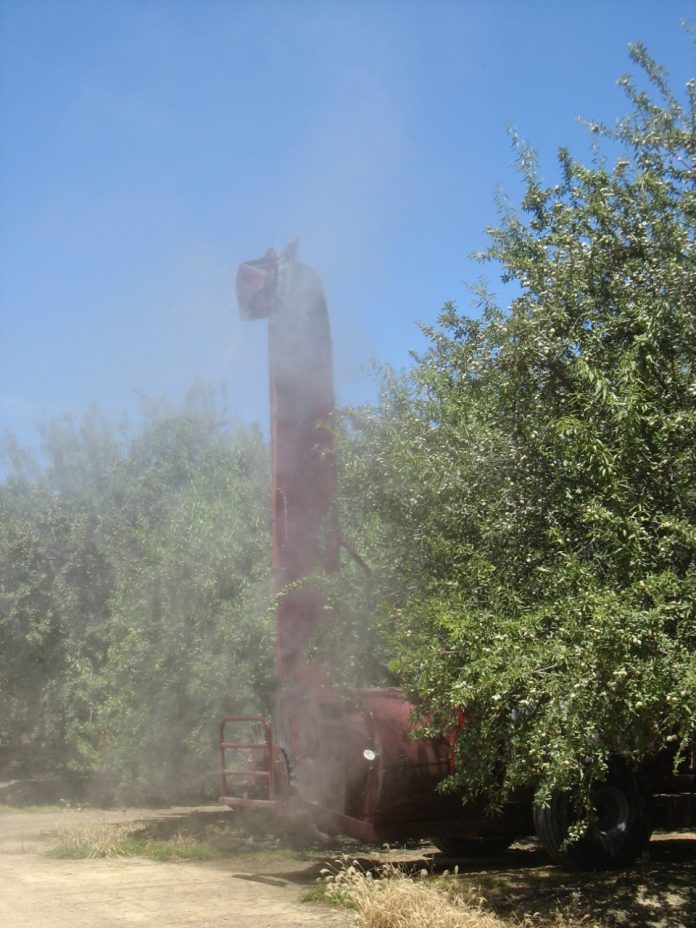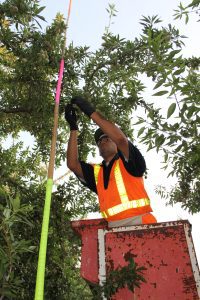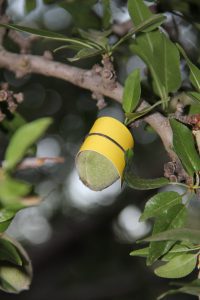
A seven-year research project into spray coverage found that a standard air blast sprayer that is properly maintained and operated delivered as good or better coverage than any applicator tested for navel orangeworm control in Nonpareil almonds.
Brad Higbee, research and development manager for Trèce Inc., who conducted the research while serving as director of entomology research at Wonderful Orchards in Shafter, Calif., said the orchard launched the project in hopes of determining how to improve spray coverage. The findings, he said, confirmed that the orchard’s spray practices were about as good as they could expect.
“We tried so many different things, from the ground speed, air speed, how fast the air is coming out of the sprayers, different droplet sizes, different nozzles,” Higbee said. “We looked at electrostatic sprayers. We looked at tower sprayers. We looked at combinations of helicopter and ground applications and also looked at them separately. We tried so many different things, and we could just get incremental improvements. It turned out that what we were doing was basically as good as it gets.”
The findings showed that regardless of application method, about the best applicators could expect was between 50% to 60% coverage, Higbee said.
“This is all focused on the navel orangeworm,” Higbee said. “So, what that means in terms of spray coverage is that it doesn’t really matter if you get residues on the leaves. The only place the residues matter in terms of naval orangeworm protection is on the hull and the nuts.
“So, it is a little more rigorous challenge than just looking at the whole tree,” he said.
Researchers found that different machines provided different degrees of coverage in different parts of trees, but that no system provided better than 60% coverage over the expanse of the tree. For example, ground rigs provided coverage of up to 80% in the bottom of trees, but only 15% or so in the tops of trees.
“And so, when you put it all together, it is usually about 50% to 60% coverage,” Higbee said.
With a tower sprayer, conversely, coverage was better in the tops of trees and was more uniform than with a ground rig, but overall coverage still averaged out to around 50% to 60%, Higbee said.
“There was nothing wrong with the tower sprayers,” he said. “It is just a question of if you want to deal with the tower and whatever additional maintenance or practical problems you might run into.”

Multiple Measurements
In the trials, researchers measured spray coverage by placing water-sensitive papers at different sites in trees, they looked at spray residues on fruit and measured nut damage, including both nut damage on trees and in windrows after harvest.
In all, researchers analyzed up to 2,000 individual nuts for product residues each year and more than 150,000 nuts were dissected for infestation and damage assessment, Higbee said.
The trial, which ran from the 2010-16 growing season, included three replicate treatments of Intrepid and Altacor on 7-acre plots. “It was quite a comprehensive trial,” Higbee said.
Navel orangeworm pressure was high during the trial, with almonds in the control plot averaging 25% to 30% damage, Higbee said.
The researchers actually dipped nuts in the control plots and still did not get 100% control, Higbee said. “In our control plots, we would dip nuts with the same mix that we sprayed, and the interesting thing there is the nuts that were dipped still had about 2% damage.”
The researchers used 200 gallons of water per acre when treating with the air blast sprayers, he said. “We couldn’t do any better or quite as good with anything less than that,” he said. “We could have gone more gallons per acre, but it becomes kind of impractical for a grower to use more than that.”
And the researchers settled on 2 miles per hour as the optimal speed to run the sprayers.
“You could get away with 2.5 miles per hour, but it was just not quite as good,” he said. “It wasn’t a trainwreck or anything, but the best was 2 miles per hour.”
The top treatments were able to secure 75% to 80% reduction in navel orangeworm damage compared to the control plots, Higbee said.
“And that was really the best we could achieve, and we did that with just standard air blast ground rigs, both PTO and engine drive. We found the PTOs could do just as well,” Higbee said. “It was just kind of a relatively standard set up. As long as it is maintained, calibrated and in good shape, that is going to be as good as you can do.”
Damage reductions averaged between 15% and 25% with a single application and between 55% to 60% with two applications.
The researchers found that three treatments provided the best control, with the addition of a third spray increasing damage reduction up to 80%. “Any more than three sprays did not give you less damage,” he said. “Two to three sprays are going to be the best you can do.”

Spray Timing
As for timing, when multiple hullsplit sprays are planned, Higbee said the best results occurred when the first spray went on “right at the onset of hullsplit.”
“And if you are going to do only do two sprays, we found that, at least in the southern valley, the most impactful for the second spray was getting as close to harvest as the product’s PHI (pre-harvest interval) would allow,” he said.
“These trials were in Kern County,” he added. “And so, this isn’t a uniform recommendation, but in the southern valley, these Nonpareils are usually coming off right when the third flight hit.
“And the residues are additive,” he said. “That is another thing we found. You put on one spray, measure the residue, and then you wait generally about three weeks, put on another spray, and you get some additive effect. Those residues are still there from the first spray.”
Researchers found that changing nozzle types, adding adjuvants or altering droplet size did not have significant effects on efficacy based on nuts sampled at harvest.
“The key to this trial is reaching the realization that we are only getting 50% to 60% coverage when it comes to navel orangeworm,” Higbee said. “Residues on leaves are not doing any good. They have to be on the nuts. And in addition to getting past branches and leaves and a lot of things that block the spray residue from getting there, there is the fact that you could have sprayed last week, but this week the nut is split open a half an inch or a quarter of an inch and you have tissue exposed that you couldn’t possibly have residue on. You have this three-dimensional, spatial, temporal change, and that is what makes it especially tough with almonds.
“And that is why the multiple sprays had the largest impact on damage reduction when you have a high-pressure situation,” Higbee said.
Higbee has given talks on the project over the years and believes the results are still relevant. He said he hoped to write several articles in the coming year to share the technical aspects of the project in West Coast Nut.















